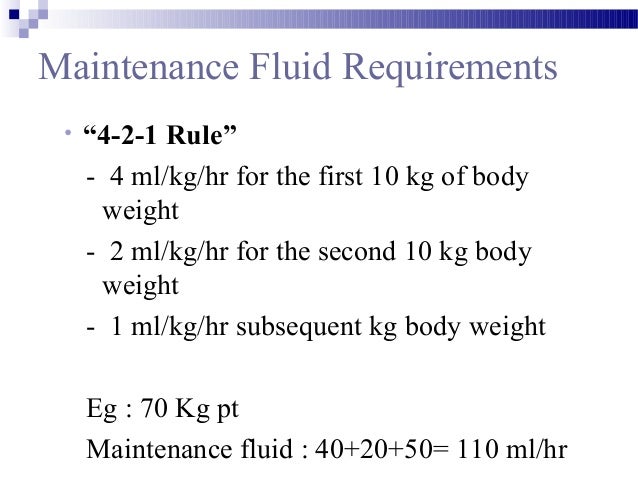1/2 NS: Free water (orally, via NGT, via PEG tube) Normal Saline (NS) D5 1/2 NS: D5W through IV: NS: Even 1/4 NS or D5 1/4 NS works for maintenance fluids: Comments if you are planning to give more than 3-4 liters of normal saline, switch to LR because of the risk of 'expansion acidosis'. This fluid was composed of a Group 1 base oil and additives to reduce oxidation, foaming, rust, corrosion, varnish, and sludge build-up. This was the world's first automatic transmission fluid designed for the world's first mass-produced automatic transmission. This fluid had cold weather performance problems which led to the need for an. In anesthetic practice, this formula has been further simplified, with the hourly requirement referred to as the '4-2-1 rule' (4 mL/kg/hr for the first 10 kg of weight, 2 mL/kg/hr for the next 10 kg, and 1 mL/kg/hr for each kilogram thereafter. AutoZone Diesel Exhaust Fluid 2.5gal $ 10. Check if this fits your vehicle. Notes: Container capacity: 2.5 gallon $ 10.
This rule helps to easily calculate the maintenance fluid needs in hospitalized patients.
Maintenance fluid can be defined as the amount of fluid required to compensate for ongoing fluid losses (insensible and sensible), thus maintaining steady state in the body.
1 2 Fluid Ounce Crossword
In a study published in 1957 in the Journal of Paediatrics, Malcolm Holiday and William Segar developed a simple rule that can be easily remembered for calculating maintenance fluid in sick children.
This rule is based on the assumption that there exists a DIRECT LINEAR RELATIONSHIP between physiologic water and energy metabolism (that is, under normal resting conditions, 1ml of body water is required to metabolize 1KCal). Jixipix hand tint pro 1 0 12 0.
These authors (Holliday and Segar), having also understood that there is a relationship (NON-LINEAR) between body weight and energy expenditure, therefore plotted a graph showing this relationship. By this, they arrived at a method that can help to calculate maintenance fluid using body weight, based on the the established DIRECT LINEAR relationship between body water and energy metabolism.
And here is the conclusion:
First 10kg (0-10kg) will require 100ml/kg/day
Second 10kg (11-20kg) will require 50ml/kg/day
Remaing kg (>20kg) will require 20ml/kg/day
This formula is then simplified to produce the 4-2-1 rule, by expressing the maintenance fluid in 'per hour' instead of 'per day'.
To achieve this, the amount of fluid is divided by 24 (since 1day= 24hours).
0-10 kg= 100ml/kg ÷ 24= 4.167 (approx. 4ml/kg/hr)
11-20kg = 50ml/kg ÷ 24= 2.083 (approx. 2ml/kg/hr)
>20kg= 20ml/kg ÷ 24= 0.83 (approx. 1ml/kg/hr)
And that's the 4-2-1 rule for calculating HOURLY MAINTENANCE FLUID.
Example 1:
What is the daily maintenance fluid for a sick child weighing 12kg? Also, calculate the maintenace fluid to be administered to this child over a period of 8hrs.
Weight of the child is 12kg (10kg + 2kg)
First 10kg= 100ml/kg/day= 100ml*10= 1000ml/day
Second 2kg= 50ml/kg/day= 50ml*2= 100ml/day
The daily maintenance fluid for the child
= 1000ml + 100ml= 1100ml/day.
To calculate the 8hrs period maintenance fluid, convert daily maintenance to hourly maintenance, and multiply the result by 8.
1100ml ÷ 24= 45.83ml/hr
Maintenance fluid for a period of 8hrs
= 45.83ml*8
= 366.64 (approx. 367ml).
Example 2:
Using the 4-2-1 rule, calculate the hourly maintenance fluid for a sick child weighing 25kg.
Weight= 25kg (10kg + 10kg + 5kg)
First 10kg= 4ml*10= 40ml/hr
Second 10kg= 2ml*10= 20ml/hr
Last 5kg= 1ml*5= 5ml/hr
The hourly maintenance fluid
= 40+20+5
= 65ml/hr.
To calculate the daily maintenance fluid, simply multiply by 24hrs
Fontagent pro 7 2 2. Daily maintenance fluid for this child= 65ml*24= 1560ml per day.
OGUNLABI, David (RN).
Overview
Compatible with video advertising
industry standards VAST and VPAID

Integrate our WordPress Plugin
and CDN hosted player
Enables easy manipulation of a number
of properties after initialisation
Video streaming support for
MPEG-DASH and HLS streaming protocols
Support for dynamic frontend frameworks
including Vue.js, React and Angular
Player Builder
Use the builder to see how easy it is to customize Fluid Player while seeing your changes in real-time in the video player
on the left, cut and paste the code created in the code generator box below the player to insert into your website
Fluid 2.1 Channel Tv Soundbar
Articles
Fluid Player updated to Version 3
Fluid Player, the free, open-source, HTML5 video player has been updated to version 3. The player has undergone a major modernization of the codebase significantly improving code quality and improving the player stability.
Fluid Player adds vr and vpaid features
Fluid Player, the free, open-source, HTML5 video player has released two new features: VR (virtual reality) support and VPAID (video player ad-serving interface definition) support.
Fluid Player master class #1: how to use the builder
If you are not an expert in writing code, this Master Class will show you how to use the Fluid Player Builder, which allows you to edit some of its key features and automatically generate the code you need to add it to your website.

